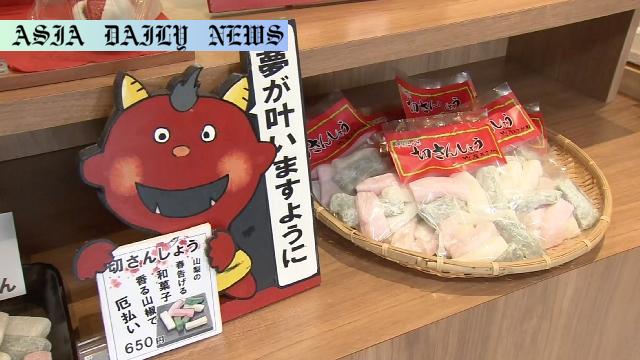Kirisansho: Sweet Japanese good luck cake made for Setsubun.
Kirisansho cake is crafted to celebrate Setsubun, marking the start of spring.
The cake incorporates Japanese pepper, believed to ward off evil spirits.
An over 130-year-old shop in Kofu City is continuing this tradition.
Kirisansho production involves rice flour, seaweed flakes, and precise crafting techniques.

The Significance of Kirisansho in Japanese Culture
Kirisansho, a traditional Japanese good luck cake, plays a pivotal role during Setsubun, a festival that marks the end of winter and the arrival of spring according to the traditional Japanese calendar. This seasonal treat is particularly popular in Yamanashi Prefecture, where locals cherish its unique taste and cultural significance. Infused with the distinct aroma and flavor of Japanese pepper, Kirisansho is believed to have the power to ward off evil spirits, aligning perfectly with the customs of Setsubun.
The Craftsmanship Behind Kirisansho
The creation process of Kirisansho is a disciplined art, reflecting the dedication and expertise of the artisans who make it. The process begins with dough prepared from rice flour and hot water, which is steamed for about 40 minutes. Key ingredients like Japanese pepper and seaweed flakes are carefully folded into the dough using specialized machinery, ensuring a harmonious blend of flavors. The dough is then dusted with starch, flattened, allowed to rest overnight, and finally cut into strips the following day.
A Legacy of Culinary Excellence
One of the oldest confectionery stores in Kofu City has been preserving the tradition of Kirisansho for over 130 years. Helmed by owner Asakawa Toshihiko, the store’s mission is to keep this culinary heritage alive and pass down its authentic flavors to future generations. Toshihiko emphasizes the cultural and spiritual significance of Japanese pepper, whose strong scent is believed to repel evil. This enduring tradition showcases Japan’s rich history and the deep connection between food and festivity.
A Seasonal Delight
Kirisansho is a seasonal specialty, produced in limited quantities around Setsubun, which falls on February 2 this year. The store plans to manufacture approximately 1,000 bags of Kirisansho until mid-February, offering local residents and visitors a chance to enjoy this unique confection. The limited availability adds to its charm, making Kirisansho a must-try delicacy for those seeking an authentic taste of Japanese culture.
Preserving Tradition in Modern Times
In today’s fast-paced world, the preservation of traditional foods like Kirisansho is both a challenge and a testament to a community’s dedication to its roots. Small businesses like the Kofu City confectionery store play a crucial role in keeping these traditions alive. By adapting age-old recipes to modern production techniques while maintaining their authenticity, such establishments ensure that cultural treasures like Kirisansho remain accessible and relevant.
Conclusion
Kirisansho is more than just a cake; it is a symbol of Japanese heritage, community, and resilience. As Japan continues to progress, traditions like the making of Kirisansho provide a comforting reminder of the country’s rich past and the enduring connection between its people and their cultural roots. Whether you’re a local or a visitor, indulging in this sweet treat during Setsubun is a delightful way to engage with Japanese traditions and taste the essence of a springtime celebration.



Commentary
Kirisansho: A Culinary Symbol of Good Fortune
Food has a unique ability to connect us to culture, tradition, and history, and Kirisansho is a perfect example of this. The practice of crafting this delightful cake for Setsubun showcases the deep-rooted belief in symbolic foods to bring good luck and drive away negative energy. In an era where convenience often overshadows tradition, it is heartwarming to see such practices still thriving in communities like the one in Kofu City.
Preserving Culinary Legacy
The meticulous process of creating Kirisansho, passed down across generations, highlights not just culinary skill but also the dedication to preserving tradition. What stands out is the unique use of Japanese pepper, which lends both flavor and cultural significance to the cake. Such ingredients, tied to folklore and symbolism, add depth and meaning to an otherwise simple dish. It’s a reminder that food can be more than sustenance—it can tell stories and bridge generations.
Relevance in Modern Times
As globalization continues to reshape cultures, the revival and celebration of local traditions like Kirisansho are crucial. They provide young people a reason to stay connected to their heritage while offering the world a glimpse into the rich tapestry of Japanese culture. Kirisansho serves both as a sweet treat and a cultural ambassador, inviting people to learn and appreciate the stories behind it.
In essence, tradition and food go hand in hand. Kirisansho is not just a cake—it’s an experience of Japanese spring, of Setsubun, and of the cultural identity that binds generations together. Here’s to such meaningful traditions continuing to thrive in modern times!